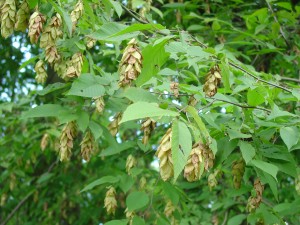Hophornbeam (Ostrya virginiana) is a medium sized tree native to the eastern half of North America (USDA hardiness zones 4-8). The tree is practically ignored by landscape designers and installers. Few nurserymen grow it.
Hophornbeam is often confused with the true hornbeams (Carpinus spp.). Both are called “ironwood”, referring to the hard muscular wood of both genera. Ostrya averages 35 to 40 feet in height and 20 to 30 feet in width in an open location. As the tree ages, its canopy becomes more rounded.
Year-round interest can be found in its flowers, fruit, foliage, tree form, and bark. The 3-5 inch long, doubly serrated foliage is medium to dark green in summer color, and finishes yellow-brown in the autumn before falling. Hophornbeam bears distinctive male and female flowers on the same tree. Small male catkin flowers, grouped in threes, are reddish to brown in color. Male flowers are visible on the tree in winter. The greenish female flowers give way to 2 ½ to 3 inches long, drooping hops-like seed pods. Tiny nutlets inside the seed pods persist most of the winter and are an important food source for birds.
Hophornbeam grows in either sun or shade, developing a full, dense canopy in full sun and in moist, well-drained, moderately acidic soils. It tends to be slow growing at first and becomes more moderate after 2 years when properly mulched and not environmentally stressed. It is remarkably shade tolerant and, in its natural woodland habitat, develops into a small 15-20 foot open-branched tree or large shrub.
A young tree exhibits smooth, muscular trunk with slender branches which grow in a zig-zag pattern. The bark gradually ages, shedding in small thin patchy pieces, valued by some for winter interest. The tree is rarely damaged by deer.


 Posted in
Posted in 
